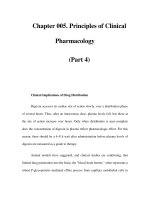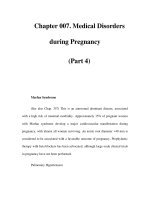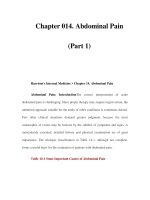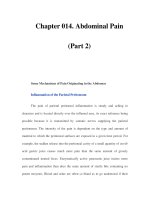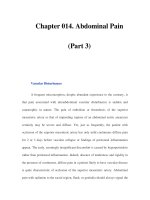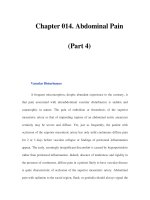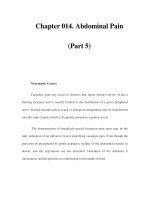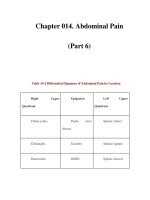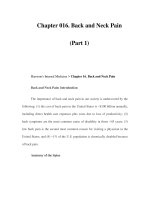Chapter 014. Abdominal Pain (Part 4) ppsx
Bạn đang xem bản rút gọn của tài liệu. Xem và tải ngay bản đầy đủ của tài liệu tại đây (12.75 KB, 5 trang )
Chapter 014. Abdominal Pain
(Part 4)
Vascular Disturbances
A frequent misconception, despite abundant experience to the contrary, is
that pain associated with intraabdominal vascular disturbances is sudden and
catastrophic in nature. The pain of embolism or thrombosis of the superior
mesenteric artery or that of impending rupture of an abdominal aortic aneurysm
certainly may be severe and diffuse. Yet, just as frequently, the patient with
occlusion of the superior mesenteric artery has only mild continuous diffuse pain
for 2 or 3 days before vascular collapse or findings of peritoneal inflammation
appear. The early, seemingly insignificant discomfort is caused by hyperperistalsis
rather than peritoneal inflammation. Indeed, absence of tenderness and rigidity in
the presence of continuous, diffuse pain in a patient likely to have vascular disease
is quite characteristic of occlusion of the superior mesenteric artery. Abdominal
pain with radiation to the sacral region, flank, or genitalia should always signal the
possible presence of a rupturing abdominal aortic aneurysm. This pain may persist
over a period of several days before rupture and collapse occur.
Abdominal Wall
Pain arising from the abdominal wall is usually constant and aching.
Movement, prolonged standing, and pressure accentuate the discomfort and
muscle spasm. In the case of hematoma of the rectus sheath, now most frequently
encountered in association with anticoagulant therapy, a mass may be present in
the lower quadrants of the abdomen. Simultaneous involvement of muscles in
other parts of the body usually serves to differentiate myositis of the abdominal
wall from an intraabdominal process that might cause pain in the same region.
Referred Pain in Abdominal DiseasesPain referred to the abdomen from
the thorax, spine, or genitalia may prove a vexing diagnostic problem, because
diseases of the upper part of the abdominal cavity such as acute cholecystitis or
perforated ulcer are frequently associated with intrathoracic complications. A most
important, yet often forgotten, dictum is that the possibility of intrathoracic disease
must be considered in every patient with abdominal pain, especially if the pain is
in the upper part of the abdomen. Systematic questioning and examination directed
toward detecting myocardial or pulmonary infarction, pneumonia, pericarditis, or
esophageal disease (the intrathoracic diseases that most often masquerade as
abdominal emergencies) will often provide sufficient clues to establish the proper
diagnosis. Diaphragmatic pleuritis resulting from pneumonia or pulmonary
infarction may cause pain in the right upper quadrant and pain in the
supraclavicular area, the latter radiation to be distinguished from the referred
subscapular pain caused by acute distention of the extrahepatic biliary tree. The
ultimate decision as to the origin of abdominal pain may require deliberate and
planned observation over a period of several hours, during which repeated
questioning and examination will provide the diagnosis or suggest the appropriate
studies.
Referred pain of thoracic origin is often accompanied by splinting of the
involved hemithorax with respiratory lag and decrease in excursion more marked
than that seen in the presence of intraabdominal disease. In addition, apparent
abdominal muscle spasm caused by referred pain will diminish during the
inspiratory phase of respiration, whereas it is persistent throughout both
respiratory phases if it is of abdominal origin. Palpation over the area of referred
pain in the abdomen also does not usually accentuate the pain and in many
instances actually seems to relieve it. Thoracic disease and abdominal disease
frequently coexist and may be difficult or impossible to differentiate. For example,
the patient with known biliary tract disease often has epigastric pain during
myocardial infarction, or biliary colic may be referred to the precordium or left
shoulder in a patient who has suffered previously from angina pectoris. For an
explanation of the radiation of pain to a previously diseased area, see Chap. 12.
Referred pain from the spine, which usually involves compression or irritation of
nerve roots, is characteristically intensified by certain motions such as cough,
sneeze, or strain and is associated with hyperesthesia over the involved
dermatomes. Pain referred to the abdomen from the testes or seminal vesicles is
generally accentuated by the slightest pressure on either of these organs. The
abdominal discomfort is of dull aching character and is poorly localized.
Metabolic Abdominal Crises
Pain of metabolic origin may simulate almost any other type of
intraabdominal disease. Several mechanisms may be at work. In certain instances,
such as hyperlipidemia, the metabolic disease itself may be accompanied by an
intraabdominal process such as pancreatitis, which can lead to unnecessary
laparotomy unless recognized. C1 esterase deficiency associated with
angioneurotic edema is often associated with episodes of severe abdominal pain.
Whenever the cause of abdominal pain is obscure, a metabolic origin always must
be considered. Abdominal pain is also the hallmark of familial Mediterranean
fever (Chap. 323).The problem of differential diagnosis is often not readily
resolved. The pain of porphyria and of lead colic is usually difficult to distinguish
from that of intestinal obstruction, because severe hyperperistalsis is a prominent
feature of both. The pain of uremia or diabetes is nonspecific, and the pain and
tenderness frequently shift in location and intensity. Diabetic acidosis may be
precipitated by acute appendicitis or intestinal obstruction, so if prompt resolution
of the abdominal pain does not result from correction of the metabolic
abnormalities, an underlying organic problem should be suspected. Black widow
spider bites produce intense pain and rigidity of the abdominal muscles and back,
an area infrequently involved in intraabdominal disease.
